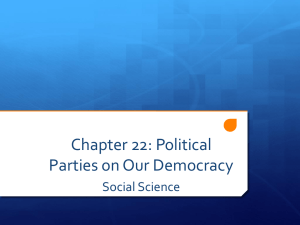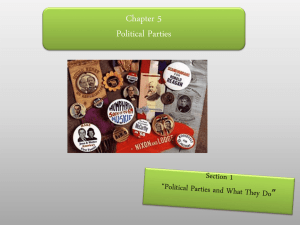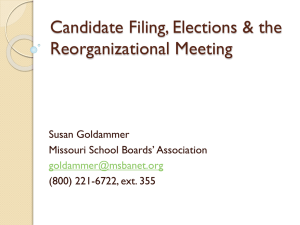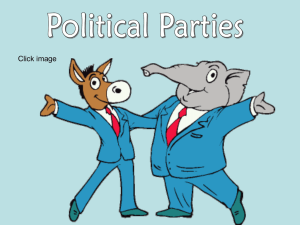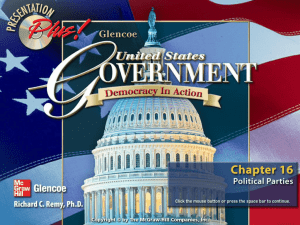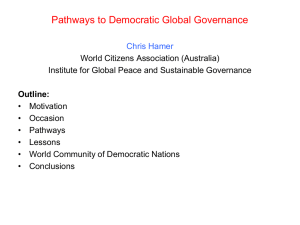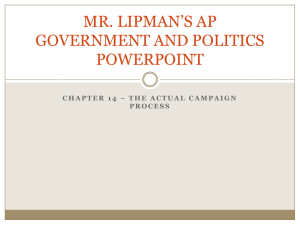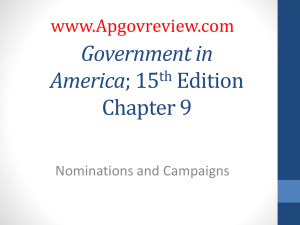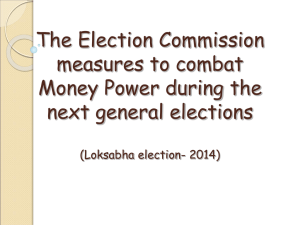PPT - the TriValley Democratic Club
advertisement
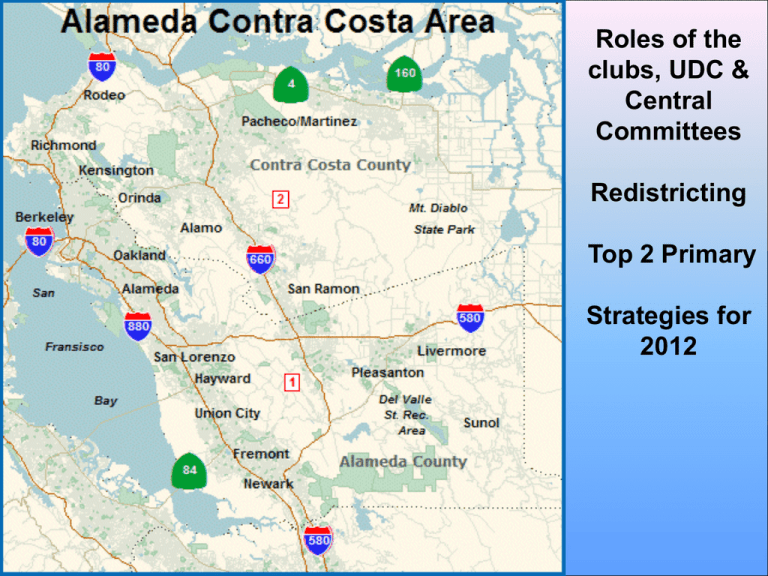
Roles of the clubs, UDC & Central Committees Redistricting Top 2 Primary Strategies for 2012 Eligible Alameda Contra Costa California 1,008,493.00 713,933.00 Registered Democratic Republican Other 753,884.00 427,764.00 117,574.00 208,546.00 75% 57% 16% 28% 510,737.00 254,849.00 134,488.00 121,400.00 72% 50% 26% 24% 23,605,858.00 17,186,531.00 7,569,581.00 5,307,411.00 4,309,539.00 73% 44% 31% 25% What’s at stake in 2012 Who wins determines what happens on the issues Democrats believe in: 53 new Congressional Districts 20 State Senate Districts 80 State Assembly Districts SOCIAL SECURITY & MEDICARE PEACE & SECURITY JOB CREATION & EDUCATION 4 Board of Equalization Districts TAX EQUITY 3 Alameda County Supervisors HEALTH CARE & SOCIAL SERVICES ___ City Council Members LOCAL DEVELOPMENT & SAFETY EDUCATION & OPPORTUNITY AIR, WATER & TRANSIT ___ School Board Members ___ Special Districts How our Party works together Central Committee Coordination Candidate recruitment Training & endorsement Resource development Clubs Leadership development Issue education & advocacy Volunteer recruitment UDCs Local campaign activities How Alameda County Organizes •United Democratic Campaign (UDC) headquarters: • Alameda • Berkeley-Albany-Emeryville • Eden Area (Hayward, San Leandro) • Oakland • Tri-Valley (Dublin, Pleasanton, Livermore) • Ohlone (Fremont, Newark, Union City) UDC activities • Phone Banking • Door-to-door canvassing • Volunteer recruitment and training • Resource development • Visibility & outreach • and more! Alameda Chartered Democratic Clubs Groups within the Alameda County Democratic Party which represent a geographical location or similar concerns Examples of clubs based on shared issues/concerns are: Alameda County Democratic Lawyers Club Asian Pacific American Democratic Caucus of Alameda County Bay Area Iranian-American Democrats Cal Berkeley Democrats East Bay Young Democrats South County Young Democrats Wellstone Democratic Renewal Club How Contra Costa County Organizes Central Contra Costa United Democratic Campaign UDC Offices in strategic locations Activities Clubs •Antioch Democratic Club •Democrats of Rossmoor •Diablo Valley Democratic Club •East County Democrats For Action •El Cerrito Democratic Club •Filipino American Democratic Caucus of Contra Costa County •Labor Democratic Club •Lamorinda Democratic Club •San Ramon Valley Democratic Club • Phone Banking • Door-to-door canvassing •Farmers Market voter registration & campaigning • Volunteer recruitment & training • Resource development • Visibility & outreach • and more! What’s Special About 2012? • Redistricting –Challenges for (some) incumbents • “Top-Two” Primary –New, earlier endorsement schedule • Voter confusion leads to voter apathy! Tonight’s Conversation How the County Party works Redistricting Top-Two Primary Resources available for the clubs Your suggestions: What can we do for you? Questions County Central Committee: Who Are We? •Members elected by Assembly District, in general elections, even years •Elected officials who live or serve in the County •Members’ alternates •“Associates” nominated by Assembly District “caucuses” •Representatives of chartered Democratic Party clubs County Central Committee: What do we do? •Send delegates to the CDP convention •Elect members of the CDP Executive Board •Coordinate the Party's activities throughout the county •Keep an online calendar of Party events •Charter United Democratic Campaigns/offices •Charter and support Democratic clubs Coordinating Activities Win Elections •UDCs facilitate local organizing •County committee can provide voter rolls, “The MOE” •County leadership can determine which elections are close and focus on those •Precinct walks •Phone banks •Funding for mailers, etc. Term Limits California State Legislature: Three two-year terms for Assembly members (six years) Two four-year terms for Senate members (eight years). US Congress No Limits Source Redistricting Partners New Districts Incumbent Term limited until AD11 Open AD14 Susan Bonilla 2019 AD15 Nancy Skinner 2015 AD16 Joan Buchanan 2015 AD18 Sandre Swanson 2013 AD20 Mary Hayashi 2013 AD23 Bob Wieckowski 2019 SD09 Ellen Corbett / Loni Hancock 2015 2017 SD07 Mark DeSaunier 2017 SD03 Lois Wolk 2017 SD 10 Elaine Alquist 2013 CD03 John Garamendi no limit CD05 Mike Thomnpson no limit CD09 Jerry McNerney no limit CD11 George Miller no limit CD13 Barbara Lee no limit CD15 Pete Stark no limit CD17 Open no limit Assembly Districts with incumbents - all Democrats AD14 Susan Bonilla AD16 Joan Buchanan AD15 AD23 Nancy Skinner Bob Wieckowski Assembly Districts term limited or open AD11 AD18 Sandre Swanson Open AD20 Mary Hayashi AD11 CD05 AD14 No longer in Contra Costa. Lost Lamorinda. AD15 AD16 Now includes Lamorinda, Dublin & Pleasanton, but excludes Elk Grove. AD18 Was AD 16, seat open in 2012. 4 declared candidates so far. AD20 AD23 Senate Districts SD09 Ellen Corbett & Loni Hancock SD03 Lois Wolk SD07 SD 10 Mark DeSaunier Elaine Alquist SD09 Was SD9/10 with elections in 2012. Incumbent Loni Hancock will face Assembly member Sandre Swanson who is term limited out of the assembly. Since Ellen Corbett remains in office until 2014, some places like San Leandro will have 2 senators for 20132014. SD10 Incumbent Senator Elaine Alquist term limited out in 2012, 2012 term limited out Assembly member Mary Hayashi started a committee, she lives in this district. Pleasanton will have 2 senators in 2013-2014, Mark DeSaunier (if he wins in 2012) & Ellen Corbett since she serves until 2014. SD07 SD03 CD15 Pete Stark CD05 Mike Thomnpson CD13 Barbara Lee Congressional Districts CD09 Jerry McNerney CD11 George Miller Congressional Districts of interest CD03 John Garamendi CD17 Open CD05 CD09 CD11 Was CD 13 No longer in Contra Costa, No longer includes Richmond. CD13 CD15 CD03 CD17 Was CD 13. Mike Honda will run here since he lives in Zoe Lofgren’s district & there is no incumbent in CD 17. From the Secretary Of State’s website Frequently Asked Questions for Voters concerning top 2 primary rules What is a Top 2 Primary? A Top 2 Primary allows voters to vote for any candidate running in each race. The two candidates who receive the most votes in the Primary Election qualify for the General Election. A candidate must also receive at least 1% of the votes cast in that race to advance to the General Election. Candidates for partisan office may state a preference for a political party, which is listed on ballots and in voters’ pamphlets. For example: John Smith Jane Doe (Prefers Democratic Party) (Prefers Republican Party) Or candidates can choose to not state a party preference. For example: John Smith(States No Party Preference) Regardless, the party preference information has no bearing on how the election is conducted or who is allowed to advance from the Primary to the General. Instead, which candidates are allowed to advance is based solely on how many votes they receive in the Primary. What is a “party preference?” Each candidate for partisan office may state a political party that he or she prefers. A candidate’s preference does not imply that the candidate is nominated or endorsed by the party, or that the party approves of or associates with that candidate. The party preference has no impact on how the election is conducted or which candidates are allowed to stay in the race to the General Election. The two candidates who receive the most votes in the Primary, and who receive at least 1% of the votes, advance to the General. The candidate has up to 16 characters to describe the party that he or she prefers. This gives the candidate great freedom. Some candidates state a preference for an established major party, such as the Democratic Party or the Republican Party, while others state a preference for novel parties, such as the No New Taxes Party. Candidates are not restricted to stating a preference to an established major or minor party. What offices are affected? The Top 2 Primary applies to partisan office. In Washington, this includes the United States Senate and House of Representatives, the State Legislature, statewide partisan office such as Governor, and county partisan office such as County Commissioner. The Top 2 Primary does not apply to elections for: President and Vice President; or Political Party Precinct Committee Officer (PCO). While there are some slight variations, elections for nonpartisan office, such as city council or judge, are conducted in a similar manner to the Top 2 Primary. Generally, the two candidates in a nonpartisan race who receive the most votes in the Primary are the only candidates allowed to advance to the General Election. If only 1 or 2 candidates file for an office, do they still have a Primary? Yes. For partisan office, there is still a Primary even if only one or two candidates file. For nonpartisan office, there is no Primary and the candidates only appear in the General Election. Will there be both a Democrat and a Republican on the ballot at the General Election? Not necessarily. First, remember that the candidates are not appearing on the ballot representing a party; they are only representing themselves. Second, remember that the primary is for voters and candidates, not political parties. The parties do not own a spot on the General Election ballot. Instead, the two candidates who appear on the ballot at the General Election are the two who received the most votes in the Primary. These candidates might prefer the same party, different parties, or not state a preference. In some races, all candidates who file declare a party preference for the same party. Do Minor Party Candidates ever make it to the General Election? Yes. In the 2008 General Election, there were many candidates who preferred minor political parties, preferred parties created by the candidate, or who stated no party preference. What is the difference between a Top 2 Primary and the Primary Elections in Other States? Almost all other states in the country conduct nominating Primary Elections. In these states, the primary is for the political parties, because the purpose of the primary is to select each political party’s nominee who will represent the party in the General Election. For example, if five Republican candidates and 4 Democratic candidates file for the office of Governor, the purpose of a nominating primary is to select the one Republican candidate and one Democratic candidate who will advance to the General Election and represent their respective parties in the General Election, and are frequently required to be a registered member of the party in order to file as a candidate. In this type of election, the candidates are representing their political party when they appear on the ballot. If the state has party registration, the candidate usually must be a registered member of the party in order to file as a candidate of the party. Also, the voters are required to affiliate with a party in order to vote in the Primary and are restricted to voting only for candidates of that party. continued In a Top 2 Primary, the primary is for the voters and candidates because the purpose is simply to winnow the number of candidates down to two. The candidates are not representing any political party when they appear on the ballot; they are only representing themselves. Candidates have great freedom to describe the party that they prefer. For example, a candidate might prefer the Pro-Life Republican Party, or the Labor Democratic Party. The party preference information for each candidate is informational only; it has no relevance to the election itself. Also, the voters do not have to affiliate with a party. The purpose of the Top 2 Primary is not to select each party’s nominees. Political parties are free to conduct their nominating procedures according to their own rules, at their own conventions, caucuses and meetings. This frees the parties to develop their own criteria for nominations, endorsements, and other public declarations of support. What is the difference between Washington’s Top 2 Primary and California’s new Primary? California just passed Proposition 14. This ballot measure creates a primary system that is similar to a Top 2 Primary, though there are some significant differences. California has very established political parties, and party registration as part of voter registration. As California implements the Top Two Primary, the state will have to address whether candidates are limited in their party preference options to the established political parties, such as the Republican or Democratic Party, or are free to describe their party preference in their own words, such as the No New Taxes Party. How did the Top 2 Primary become law? The Top 2 Primary was passed by the people in 2004 as an initiative. Initiative 872 passed by almost 60%. In 2005, before the new law was implemented, the Washington state Democratic, Republican and Libertarian Parties sued in federal court. The lower courts imposed an injunction prohibiting the state from implementing the new Primary, but in March 2008 the U.S. Supreme Court upheld the new law. The new Primary was used for the first time in the 2008 Primary and General. It was used for select partisan races in 2009, and now in the 2010 Primary and General. Does Washington have Party Registration? No. Washington does not have party registration as part of voter registration. Voters do not have to declare a party affiliation either when they register or vote. Can a voter still write in a candidate? Yes. Each race on the ballot will still have a write in line for a voter to write in the name of a candidate. California Democratic Party - Rules Committee: Summary of Endorsement Process and other By-Law Changes MEMO – Updated Aug 18, 2011 The CDP Rules Committee continued to review the needed changes for Prop 14 and other endorsement issues and passed out of Committee a package of changes at a June 18, 2011 meeting. After review and amendments, the CDP Executive Board adopted these changes on July 31, 2011. Some of the important changes: 1. Timeline: In order for the CDP endorsement to be in the sample ballot, we must do our endorsements prior to the close of filing. We have Convention February 10-12, 2012. Local endorsing caucuses will be in January. 2. Self Identified Weight: Endorsements are treated differently for self-identified Democrats and non self-identified Democrats. Preference is weighted to self-identified Democrats. 3. Decline to State: If no Democrat is in the run off, the Party considered, but rejected, the ability to support a Decline to State candidate. Step by Step Process as it relates to 2012: Dec 8, 2011: Deadline for any delegate changes that are to affect Endorsements/Convention January 2012: Pre-Endorsement Conferences in District. Pre-endorsement conferences are for ONLY for self-identified Democratic candidates. Voting members: DSCC Members who live in the district County Committee Members who live in the district (who are not DSCC members) Club Representatives who live in the district (1 per 20 registered in each AD using the old AD lines) Vote Thresholds: • 70% to be placed on the consent calendar at convention • Any race with a candidate receiving more than 50% and less than 70% goes to a caucus at convention. • Any recommendation to the consent calendar may be pulled up to 10 days prior to convention with 20% of the DSCC in the District or now 20% of the DSCC statewide (around 600) filing a letter of objection. (old rules were 20% in the district and 300 statewide) February 10-12, 2012: State Endorsing Convention At the State Convention, we will take up all races which automatically were to be considered at convention due to a candidate getting more than 50% and less than 70%) as well as any that were successfully pulled. Voting members: DSCC Members who live in the district, or their qualified proxies TVDC timeline Oct 17, 2011 club meeting Elect delegates to the district pre-endorsement conference Nov 21, 2011 club meeting Dec 8, 2011: Deadline for any delegate changes that are to affect Endorsements/Convention Dec 10, 2011 club meeting – holiday party Jan 2012: Pre-Endorsement Conferences in District. Pre-endorsement conferences are for ONLY for self-identified Democratic candidates. Feb 10-12, 2012: State Endorsing Convention @ CDP Convention
